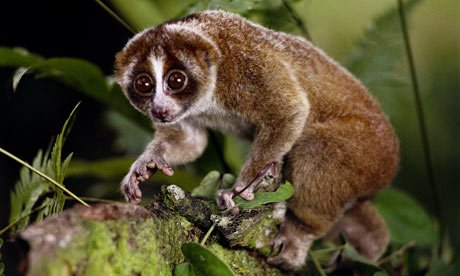
A new species of small nocturnal primate has been discovered by scientists in Borneo.
The primate is a type of slow loris, a small cute-looking animal that is more closely related to bushbabies and lemurs than to monkeys or apes.
Uniquely among primates, they have a toxic bite, belying their appearance.
Two previously known subspecies of slow loris have also been accorded full species status.
Details of the discoveries are published in the American Journal of Primatology.
The new species of slow loris, named Nycticebus kayan, has gone unrecognized until now, in part due to its nocturnal lifestyle.
Animals that are active by night often rely less on visual clues, and can therefore appear more similar to one another.
So the scientists had to look hard to discover the differences between the new species.
An international team of researchers, led by Professor Anna Nekaris of Oxford Brookes University in the UK, and Rachel Munds from the University of Missouri in Columbia, US, surveyed slow lorises living in the forests of Borneo and the Philippines.
They focused on studying the primates’ facial markings, which take the appearance of a mask, with the eyes being covered by distinct dark patches and the heads by varying patterns.

This research has revealed there are actually four species of slow loris in the Philippines and Borneo, each with their own, subtly different but distinct head markings.
Originally there was thought to be just a single species, called N. menagensis.
Two of these new species, N. bancanus and N. borneanus, were previously considered subspecies of N. menagensis.
While, N. kayan, is new to science.
“In Borneo in particular, from where three of the new species hail, this will mean that three new lorises will be added as threatened to some degree on the IUCN Red List of threatened species,” says Prof. Anna Nekaris.
“With more than 40% of the world’s primates already threatened with extinction, this brings the toll even higher.”
Outside of Borneo and the Philippines, four other slow loris species are known, living across south and southeast Asia.
All have a difficult relationship with humans.
They are the only primates with a toxic bite, secreting the toxin from glands in their elbows.
Slow lorises lick this toxin, and mix it with their saliva. They then use it when they bite, or to coat the fur of their offspring, possibly as a way to deter predators from attacking their young.
The toxin is powerful enough to potentially cause fatal anaphylactic shock in people.
But the slow lorises’ cute appearance also makes them a favored target of the pet trade.
Captured animals often have their canine and incisor teeth pulled out before being sold on as pets, in a bid to protect their potential owner.
Harming the animals this way, though, can quickly lead to their death, as the toothless primates are unable to feed properly.
The discovery that more slow loris species exist also has implications for their survival.
“Well-meaning groups rescue lorises and rarely follow proper guidelines when releasing them back to the wild,” says Prof. Anna Nekaris.
“That means that the wrong species of loris has found itself in many a new place throughout Asia, if they have survived the traumatizing practice of hard release to the wild in the first place.”